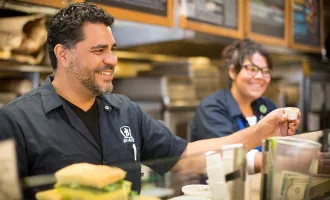The Best Coffee — Home Brew Edition
Back in my high school, making coffee was simple. I had a small Mr. Coffee machine on the far corner of my desk, a gallon of generic bottled water under my chair and a bag of Maxwell Blend in my middle drawer.
This setup ensured that didn’t even have to get out of my chair to make myself a cup of coffee, a convenience that may have played a role in my four-cup-a-day habit, which I am still recovering from.
To my credit, high school was also the time when I stopped adding milk and sugar to my coffee, although this was entirely due to laziness, rather than my refined tastes. Why get out of your chair to get milk from the fridge when you can just drink your coffee straight from the carafe?
Now that I’m living in San Francisco, I’ve noticed that there are two topics of conversation that will inevitably pop up as party conversation starters and awkward first-date fillers.
The first is to complain about how expensive it is to live in San Francisco. “You think your place is expensive? My friend’s friend pays $2,000 a month to live in an outhouse in the Marina!”
The second is to talk about the obsession to find the “best of” in The City: the best ice cream, the best breakfast pastry, the best notary public/bar mitzvah promoter.
In the quest to find the best coffee in San Francisco, I couldn’t ignore the burgeoning interest among the city’s elite (the big three — Mission unicyclists, English majors now working for tech companies and Tendernob gentrifiers) to make that perfect cup of coffee at home.
I completely sympathize — if I’m paying $30 a pound for organic fair-trade single- origin coffee made in a women’s co-op in Guatemala, I’m sure as Fell Street not going to be using my Mr. Coffee.
But with the glut of different methods, from the swirl-and-chug to the $11,000 Clover Coffee machine, what’s a discerning coffeelitist to do?
This column is devoted to my exhaustive quest to determine the best way to prepare coffee at home. I decided to test three different methods that I had read about in a Tumblr post <which one?>: the French Press, the Hario V60 and the Chemex.
For those of you not among the coffee 1 percent, the Hario V60 is a cone used for pour-over coffee that has become the Ford Model T among San Francisco’s sizable population of young bourgeois coffee snobs.
The Chemex is a popular alternative, an hour-glass-shaped contraption that can double as an Erlenmeyer flask in a pinch.
Because money is short (this ain’t the New York Times circa 1960), I only had the opportunity to test one type of coffee, so no promises on the applicability of these results if you’re not making a cup of Coava Kochere from the Coffee Commissary in Los Angeles.
A short note on the methods — the coffee was precisely prepared according to the manufacturer’s instructions and blind taste-tested in unadulterated form by three independent reviewers, who have a combined 50 years of coffee snobbery between them.
The winner? Two of the reviewers chose the Hario V60 as their favorite, noting how the coffee retained most of the notes that the bag told us we should note. In addition, the coffee had a full-bodied flavor that managed to hold up even as it cooled.
The third reviewer chose the Chemex, noting its clean taste and its ability to accentuate the acidity of the brew without making it overpowering.
The French press ended up last in our rankings, a surprise to one of the reviewers, who exclusively prepares coffee using this method. While the French press produced the fullest body, the bitterness overwhelmed the notes of the beans and became even more pronounced as the cup cooled, which didn’t do it any favors.
For those of you interested in following along at home, I should note that coffee snobbery doesn’t come cheap.
A three-cup Chemex will run you $34, while a four-cup Bodum French press will set you back $38. The Hario V60 is the cheapest among the options, costing about $20 for a ceramic or glass model.
Of course, any self-respecting member of the coffeegentsia would not be caught dead pouring out hot water out of any old kettle, so make sure to set aside $48 for the Hario Buono water kettle, with its swan-neck design, which maximizes control over the pour when using the Chemex or V60.
Finally, don’t even think about using regular filters from Costco — both Hario and Chemex produce filters specifically for their products.
Sounds like too much? Would you rather eyeball your coffee grounds than pull out your calibrated kitchen scale to maintain that 1 gram:16 milliliter coffee-to-water ratio? Have you decided that paying $100 for coffee equipment isn’t the best use of your student loans? After rereading this column, I don’t blame you.
Stay tuned for my next column, when the Synapse buys me a Clover Coffee machine.


